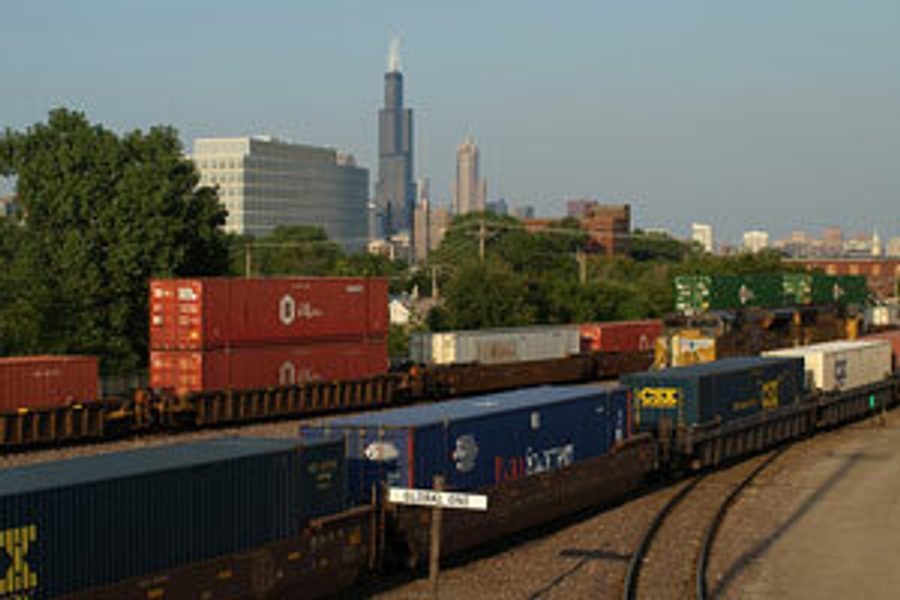
On Thursday April 28, 10 workers from a Kraft-Cadbury warehouse in the Chicago suburb of Joliet filed discrimination claims with the Equal Employment Opportunity Commission alleging race, gender and age discrimination. Managers have done nothing to address graffiti depicting swastikas and the letters “KKK” in break rooms and bathrooms at the warehouse, the workers say, or to deal with a worker who flies a Confederate flag on his truck.
April 28 happened to be the 40th anniversary of the Occupational Safety and Health Administration (OSHA). When OSHA was founded, the warehousing and international goods movement or “logistics” industry was tiny compared to today. Now, it is the major employer in many areas, including the southwest Chicago suburbs and California’s Inland Empire.
While death and injury in the sector would have hardly been a blip on the radar screen when OSHA was founded, today the transportation and warehousing industry has the second highest annual number of worker deaths, behind construction, according to 2009 statistics noted in a report released in March by Occidental College and the University of Southern California: “Global Trade Impacts: Addressing the Health, Social and Environmental Consequences of Moving International Freight Through Our Communities.”
The transportation and warehousing industry also had the third highest annual per capita rate of worker injury fatalities, after “agriculture, forestry, fishing and hunting” and mining.
The report notes that in California, warehousing and trucking were on OSHA’s “highest hazard occupation” list for 2009-2010. It cites extreme heat stress and lung cancer from diesel exhaust among health risks for people working in warehouses and driving trucks and locomotives.
In fact, the California Air Resources Board, a division of the state EPA, found that truck driving is among the five highest risk jobs for lung cancer. A study of 31,000 union trucking workers found they developed higher rates of lung cancer the longer they’d been in the industry. And railroad workers showed a 2.5 percent per year increase in risk of chronic obstructive pulmonary disease in the years after diesel locomotives were introduced.
Other studies have found that in southern California, truck drivers are highly likely to live in low-income neighborhoods surrounding ports and trucking routes, so they are exposed to high levels of diesel emissions even on their off-time. (See my April 2010 Working In These Times article on this topic.)
The Global Trade report notes the role of organized labor in addressing the health and environmental effects of expanding port and warehousing complexes. In southern California, it says:
Organized labor has struggled to build significant bargaining power in the region’s primary logistics and residential construction industries…Unions affiliated with Change to Win have turned attention to goods movement industries.
The Warehouse Workers United campaign, for example, has focused attention on the growing temporary, contingent workforce related to the expansion of warehouse and distribution centers in the Inland Valleys. The United Food and Commercial Workers union is engaged in a worker organizing campaign focused on major food retailers such as Walmart and Tesco (Fresh & Easy).
Also in San Diego, the report notes that the International Brotherhood of Electrical Workers (IBEW) and the International Longshore and Warehouse Workers Union (ILWU) have played a key role in helping a grassroots environmental group – the Environmental Health Coalition – to push the port authority to develop clean power generation in order to close down a dirty peaker power plant and to let ships at berth rely on electricity rather than running their diesel engines.
The report also highlights Warehouse Workers for Justice in the Chicago area:
The new WWJ was founded realizing that the union’s traditional base was shrinking as electrical manufacturing jobs continued to be shipped overseas. UE wanted to try to reach out to logistics industry workers, where it saw jobs that cannot be outsourced and saw warehouse workers with the “potential to build power.”
Labor is also a key part of the equation at the massive port in Newark/ New York. The Global Trade study notes that there, ”The Coalition for Healthy Ports also draws upon research by Rutgers University’s School of Management and Labor Relations on the low wages and poor working conditions of port truck drivers in the trucking industry.”
As the report notes, ports, warehousing complexes and shipping routes are undergoing massive expansions across the country, from the inland valleys of southern California to Detroit to the Gulf Coast. The renovation and widening of the Panama Canal, in particular, is driving expansion of southern and eastern U.S. ports, including Baltimore, Savannah, Miami and Charleston, to prepare for the larger container ships that will soon be able to pass through the canal.
As many of these areas are otherwise economically struggling — pummeled by de-industrialization, Hurricane Katrina and other forces — the jobs and investment from expanding ports are sorely needed. Coalitions of labor, health, environment and community groups are crucial to making sure that these expansions provide real economic growth and address the inevitable health consequences.
In an industry where the bottom line is finely calibrated and companies compete globally to see who can move products the most cheaply, that’s no small challenge.
Kari Lydersen is a Chicago-based journalist, author and assistant professor at Northwestern University, where she leads the investigative specialization at the Medill School of Journalism, Media, Integrated Marketing Communications. Her books include Mayor 1%: Rahm Emanuel and the Rise of Chicago’s 99%.








